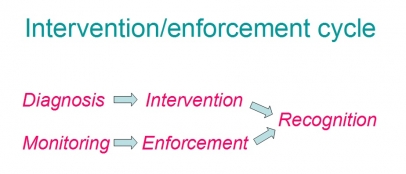Add a comment
The Intervention and Enforcement Cycles, Part 1
‹-- PreviousNext --›Following on from my post on rehearsal pacing, here at last is the first post about the Intervention and Enforcement Cycles. These describe the two fundamental processes that underlie the process of rehearsing an ensemble, and which can thus be used to analyse the detail of what we do with our choirs and maximise both the efficiency and effectiveness of our work with them.
Today I will outline how they work, and what the main differences are between them. In my next post I will discuss some common inefficiencies whereby directors let effectiveness leak out of their rehearsals. And the third post will give some extra hints and tips for good practice.
So, the two cycles look like this:

The Intervention Cycle goes: diagnosis (identify what’s needed), intervention (make the change), recognition (acknowledge the result). The Enforcement Cycle has a parallel structure that goes: monitoring (check if everyone’s doing it), enforcement (remind those that aren’t), recognition (acknowledge the result).
The main distinction between the two is therefore that the Intervention Cycle introduces a new change, while the enforcement cycle is about maintaining and embedding previously-made changes. Intervention is thus the means by which an ensemble makes progress, but Enforcement is the means by which it keeps those gains.
If you are working with human beings, you will usually find you need to do Enforcement more often than Intervention. It is a rare change that is made once and transforms habitual ways of doing things without reminder. Indeed, Jim Clancy’s principle that rehearsal should be about turning Category 2 skills (things you know how to do and that you currently do some of the time) into Category 1 skills (things you know how to do and that you do all the time) sees the Enforcement Cycle as overwhelmingly more important than Intervention.
There is a second key distinction between them that means that you can also get a lot more Enforcement done in the same time it takes to do a single Intervention. Enforcement can be done within the flow of the music, using eye contact and gesture, whereas to make an Intervention, you need to stop the music to make it. This is because the Intervention is about adding new information: your singers can’t absorb it, let alone act on it, at the same time as they are actively producing musical sound. But Enforcement only needs to trigger information they already possess, so can happen mid-song.
(The research I did on speech- and song-accompanying and conducting gesture for my second book produced some wonderful examples of how this works in practice. Directors gesture spontaneously as they explain and demonstrate what they want their singers to do, then these gestures re-emerge as didactic gestures mid-music, sometimes at the other end of the rehearsal from where the idea was first raised.)
But apart from these differences, the two cycles operate in pretty much the same way. In particular, they both:
- Need framing as positive to-dos. Give an instruction: ‘Stand tall’; ‘Straight to the target vowel’; ‘Let me hear the love in your voice’. This in turn means they
- Give singers opportunities to achieve something. If the experience of rehearsal pacing is defined by the frequency chances to succeed, these cycles are the means by which we create these opportunities. Give ‘em a box to tick. And so they
- Only offer their pay-off when the cycle is completed with Recognition. The singers need to know if they ticked the box correctly in order to feel the satisfaction.
Most rehearsal inefficiencies are in effect a failure of one of those three points. But we’ll look in more detail at how that looks in practice in my next post.










